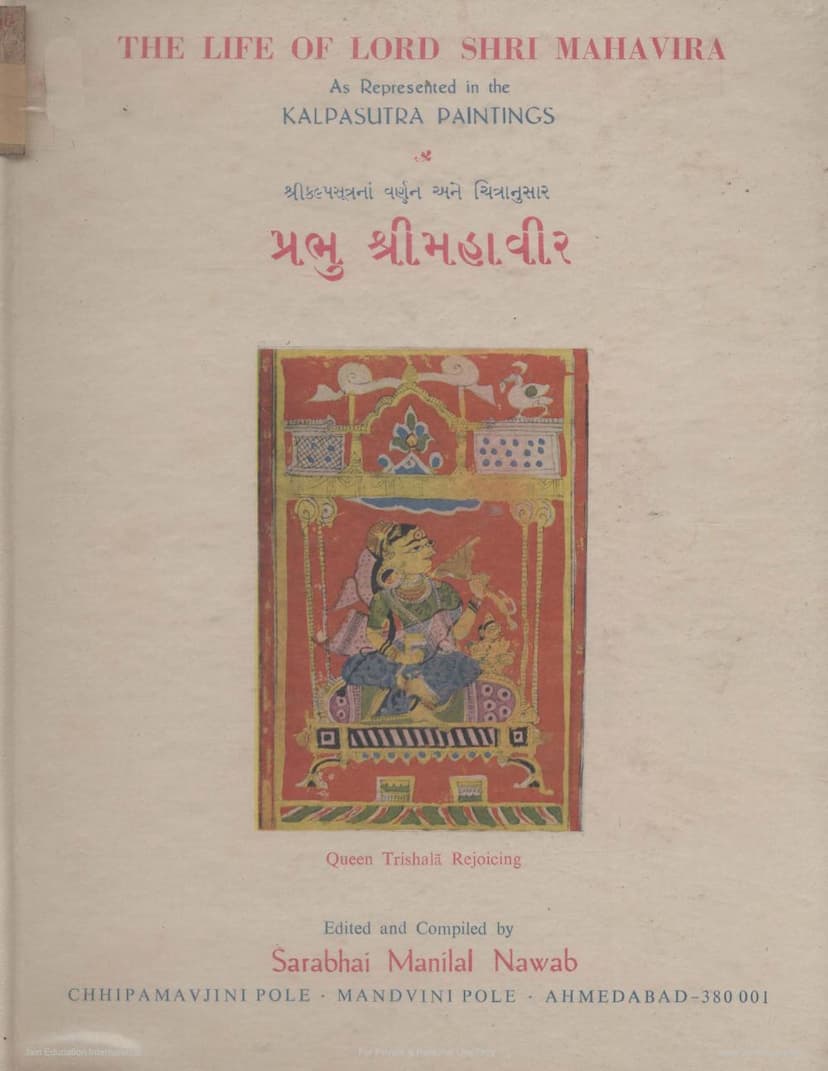Life Of Lord Mahavira
Added to library: September 2, 2025

Summary
This comprehensive summary details the contents and significance of "The Life of Lord Shri Mahavira as Represented in the Kalpasutra Paintings" by Sarabhai Manilal Nawab.
Book Overview:
- Title: The Life of Lord Shri Mahavira as Represented in the Kalpasutra Paintings
- Author/Compiler: Sarabhai Manilal Nawab
- Publisher: Sarabhai Manilal Nawab, Ahmedabad, India
- Series: Shree Jain Kala-Sahitya Samshodhan Series (Jain Art and Literature Research Series), Volume 18
- Publication Year: 1978 (V.S. 2034)
- Content: This book presents 168 paintings derived from ancient Jain Kalpasutra manuscripts, illustrating the life of Lord Mahavira. Each painting is accompanied by a description and significance in both Gujarati and English.
- Purpose: The publication aims to showcase the rich artistic heritage of Jain painting and provide visual documentation of Lord Mahavira's life and teachings, drawing from various Jain manuscript collections across India.
Publisher's Note and Vision:
Sarabhai Manilal Nawab, in his publisher's note, expresses his long-standing dedication to researching and publishing Jain art and literature. He mentions previous publications in the Shree Jain Kala-Sahitya Samshodhana Series, including "Barsasūtra (Kalpasūtra)" and "Sadāvasyaka Bālāvadhabodha." He was inspired to create this work by a dream and a desire to share the captivating life and teachings of Lord Mahavira with the world, contributing to the understanding of Indian art history. He highlights the importance of preserving the centuries-old Jñāna Bhandaras (libraries of knowledge) as repositories of spiritual and artistic heritage.
Manuscript Sources:
The book draws illustrations from 26 different palm-leaf and paper manuscripts, dating from the late 14th century to the 17th century. The publisher meticulously lists these manuscripts, including their collection details, script, dating, number of miniatures, and the specific figures (paintings) selected from each. Notable manuscript collections include those from Idar, Ahmedabad (Dehelāno Upāśraya, Dayavimalji Sastra Sangraha), Patan (Hemachandracharya Gyān Mandir), Baroda (Hamsavijayaji collection), Jira (Punjab), and Jaisalmer.
Content and Depiction of Lord Mahavira's Life:
The book meticulously chronicles the life of Lord Mahavira through the detailed descriptions and interpretations of the Kalpasutra paintings. The illustrations cover key events, including:
-
Pre-birth Events:
- The descent of Mahavira's soul from the Puspottara celestial palace.
- The auspicious dreams of Queen Trishala (eleven out of fourteen are depicted and described).
- The transfer of the embryo from Devānanda to Queen Trishala by Hariṇaigameṣin.
- The interpretation of the dreams by scholars for King Siddhartha and Queen Trishala.
- The divine showering of wealth (Navanidhana) upon Siddhartha's palace.
- The joyous celebrations and divine interventions during Mahavira's birth.
- The ceremonial bath of Mahavira on Mount Meru, with Indra and other gods participating.
- The arrival of fifty-six Dikkumaris (goddesses) to assist in the birth and subsequent ceremonies.
-
Childhood and Youth:
- Depictions of Mahavira as a child playing games, demonstrating his extraordinary strength and divine nature, even challenging gods in disguise.
- Siddhartha's arrangements for Mahavira's education and the grand procession to the school.
- Mahavira's marriage to Yasoda.
-
Renunciation and Asceticism:
- Mahavira's decision to renounce worldly life, symbolized by his renunciation of possessions and his departure in a palanquin.
- The symbolic act of plucking out his hair by five handfuls as he embraces asceticism.
- Various austerities undertaken by Mahavira and the challenges (upasargas) he faced from beings like the cowherd, Sulapani Yaksha, Naga Sudamstra, Kataputana, and Sangamaka Deva, all of which he endured with unwavering equanimity.
-
Enlightenment and Teachings:
- Mahavira's Samavasarana (divine preaching assembly), a magnificent circular structure erected by gods.
- The conversion of prominent figures like Indrabhuti Gautama (who attains omniscience) and Arya Sudharma.
- Depictions of Mahavira preaching to the four-fold Jain assembly.
-
Nirvana:
- The final moments of Mahavira's life and his attainment of Nirvana (Siddha state).
- The process of Mahavira's funeral ceremony performed by the gods.
Artistic Significance:
The book emphasizes the artistic quality of the Kalpasutra paintings, noting the use of gold ink, intricate details, vibrant colors, and skilled craftsmanship. It highlights how these paintings not only serve a religious purpose but also offer valuable insights into the art, culture, and social practices of the periods from which the manuscripts originate. The descriptions often point out the unique stylistic features and the artist's interpretation of events.
Overall Impact:
"The Life of Lord Shri Mahavira as Represented in the Kalpasutra Paintings" is a significant contribution to Jain scholarship and art history. It serves as an invaluable resource for understanding the life of Lord Mahavira through the lens of ancient Jain art, making the teachings and life story accessible and visually engaging for a wide audience. The detailed cataloging of manuscripts and illustrations underscores the meticulous research undertaken by Sarabhai Manilal Nawab.